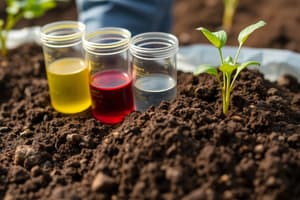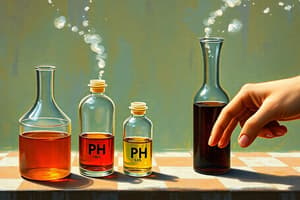Podcast
Questions and Answers
What should be done with the tin strip after each analysis?
What should be done with the tin strip after each analysis?
- Rinse it with distilled water. (correct)
- Discard it after each use.
- Wipe it with a cloth.
- Leave it unwashed for the next analysis.
What indicates a sufficient amount of available potassium in soil?
What indicates a sufficient amount of available potassium in soil?
- A uniform orange color throughout the solution.
- A distinct cloudy yellow layer on top of the solution. (correct)
- A strong odor emanating from the solution.
- A clear liquid with no observations.
How many drops of solution K2 should be added to the test tube?
How many drops of solution K2 should be added to the test tube?
- 10 drops, added quickly.
- 8 drops, mixed into the solution.
- 12 drops, added one at a time. (correct)
- 15 drops, added all at once.
What should be done after mixing the soil sample with solution K and K1?
What should be done after mixing the soil sample with solution K and K1?
What is the first step in testing for potassium in the soil?
What is the first step in testing for potassium in the soil?
What should you do if the soil pH is greater than 5.8?
What should you do if the soil pH is greater than 5.8?
How many times should you mix the soil sample when testing nitrogen content?
How many times should you mix the soil sample when testing nitrogen content?
What can cause specific deficiency symptoms in plants?
What can cause specific deficiency symptoms in plants?
What is the purpose of allowing the test tube to stand for 5 minutes during the pH test?
What is the purpose of allowing the test tube to stand for 5 minutes during the pH test?
Which part of the plant typically shows symptoms of nutrient deficiency for mobile nutrients?
Which part of the plant typically shows symptoms of nutrient deficiency for mobile nutrients?
If the soil pH reading falls between two color indicators, you should:
If the soil pH reading falls between two color indicators, you should:
Which of the following is the correct order for the phosphorus test procedure?
Which of the following is the correct order for the phosphorus test procedure?
What is a characteristic of immobile nutrients within plants?
What is a characteristic of immobile nutrients within plants?
What safety precautions should be taken when handling solution N?
What safety precautions should be taken when handling solution N?
Why is it essential to manage soil fertility through fertilizer application?
Why is it essential to manage soil fertility through fertilizer application?
What impact do deficiency symptoms have on plant growth?
What impact do deficiency symptoms have on plant growth?
What should you do after matching the soil pH color with the chart?
What should you do after matching the soil pH color with the chart?
For which purpose is solution CPR primarily used?
For which purpose is solution CPR primarily used?
Which statement is true regarding the mobility of nutrients in plants?
Which statement is true regarding the mobility of nutrients in plants?
What is one of the objectives of visual evaluation of nutrient deficiency in plants?
What is one of the objectives of visual evaluation of nutrient deficiency in plants?
What effect does nutrient concentration have on mobile nutrients during deficiency?
What effect does nutrient concentration have on mobile nutrients during deficiency?
What symptom indicates a nitrogen deficiency in plants?
What symptom indicates a nitrogen deficiency in plants?
Which element deficiency is associated with leaves that have necrotic spots and edges that stay green?
Which element deficiency is associated with leaves that have necrotic spots and edges that stay green?
What symptom would most likely suggest a phosphorus deficiency?
What symptom would most likely suggest a phosphorus deficiency?
Which deficiency is indicated by plants with bluish-green leaves and shortened stems?
Which deficiency is indicated by plants with bluish-green leaves and shortened stems?
What is a primary symptom of boron deficiency in plants?
What is a primary symptom of boron deficiency in plants?
Which deficiency is commonly suggested by wilted edges and necrotic spots on older leaves?
Which deficiency is commonly suggested by wilted edges and necrotic spots on older leaves?
What symptom signifies that the terminal bud has died?
What symptom signifies that the terminal bud has died?
Which deficiency is most likely if the plant exhibits symptoms of interveinal chlorosis?
Which deficiency is most likely if the plant exhibits symptoms of interveinal chlorosis?
What deficiency symptom is typically associated with a lack of calcium in plants?
What deficiency symptom is typically associated with a lack of calcium in plants?
Which nutrient deficiency could result in stunted growth and necrotic leaf patches in crops?
Which nutrient deficiency could result in stunted growth and necrotic leaf patches in crops?
Which macronutrient is responsible for photosynthesis and energy transfer in plants?
Which macronutrient is responsible for photosynthesis and energy transfer in plants?
How can farmers utilize visual symptoms to improve crop health?
How can farmers utilize visual symptoms to improve crop health?
Which of the following correctly distinguishes nutrient deficiency symptoms from disease symptoms?
Which of the following correctly distinguishes nutrient deficiency symptoms from disease symptoms?
What visual symptom can indicate iron deficiency in crops?
What visual symptom can indicate iron deficiency in crops?
Which mineral is most likely to cause necrotic leaf spots when deficient?
Which mineral is most likely to cause necrotic leaf spots when deficient?
Which nutrient plays a significant role in regulating water processes in plants?
Which nutrient plays a significant role in regulating water processes in plants?
Study Notes
Soil pH Test
- Fill a test tube with soil sample to the 1st scratch mark, then add CPR pH indicator dye up to the 2nd scratch mark.
- Mix gently by swirling 20 times and let stand for 5 minutes before matching color to pH color chart.
- If pH > 5.8, use BTB; if pH ≤ 5.4, use BCG for retesting.
- If color is not matched on BTB or BCG, refer to CPR for final reading.
- Clean test tube thoroughly with distilled water after each test.
- Soil pH ranges: 9.0 (extremely alkaline), 6.7-7.2 (near neutral).
Nitrogen Test
- Use a test tube and fill with soil to the 1st scratch mark; add solution N to the 2nd scratch mark (contains strong acid).
- Mix the solution 30 times and let it stand for 30 minutes.
- Match color with the chart to determine available nitrogen levels (low, medium, high).
- Refer to fertilizer recommendation table for crops.
- Rinse test tube with distilled water afterwards.
Phosphorus Test
- Fill test tube with soil to the 1st mark, add solution P to the 2nd mark and 4 drops of P1 (contains strong acid).
- Mix for 1 minute and let it stand for 5 minutes, then repeat after 3 minutes.
- Use a tin strip to stir the solution slowly; match blue intensity with the color chart.
- Follow fertilizer recommendations based on results from the chart.
Potassium Test
- Fill test tube with soil to the 1st scratch mark, add solution K to the 2nd mark and 8 drops of K1.
- Mix for 1 minute, wait 5 minutes, then add K2 dropwise (do not mix).
- A distinct cloudy yellow layer indicates sufficient potassium; no cloudiness indicates deficiency.
- Rinse test tube with distilled water after use.
Nutrient Deficiency Symptoms
- Growth reflects internal processes; necessary elements must be balanced for plant health.
- Specific deficiency symptoms vary by plant species; low levels of nutrients lead to identifiable physical symptoms.
- Nutrients vary in mobility: mobile nutrients move to younger leaves, while immobile nutrients typically affect older leaves.
Observations of Deficiency Symptoms
- Symptoms can indicate nutrient deficiencies based on plant parts affected (e.g., older leaves yellowing for nitrogen deficiency).
- Diagram available to evaluate nutrient deficiencies based on symptoms observed in experimental and field conditions.
Study Questions
- Functions of primary macronutrients must be elucidated.
- Distinction between nutrient deficiency symptoms and disease symptoms should be clear.
- Visual identification of nutrient deficiencies helps farmers manage crop health effectively.
Studying That Suits You
Use AI to generate personalized quizzes and flashcards to suit your learning preferences.
Description
This quiz covers the essential procedures for conducting soil pH, nitrogen, and phosphorus tests. You will learn about the materials needed, the step-by-step processes for each test, and how to interpret the results. Enhance your understanding of soil testing and its importance in agriculture.




